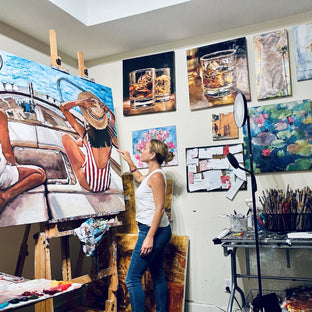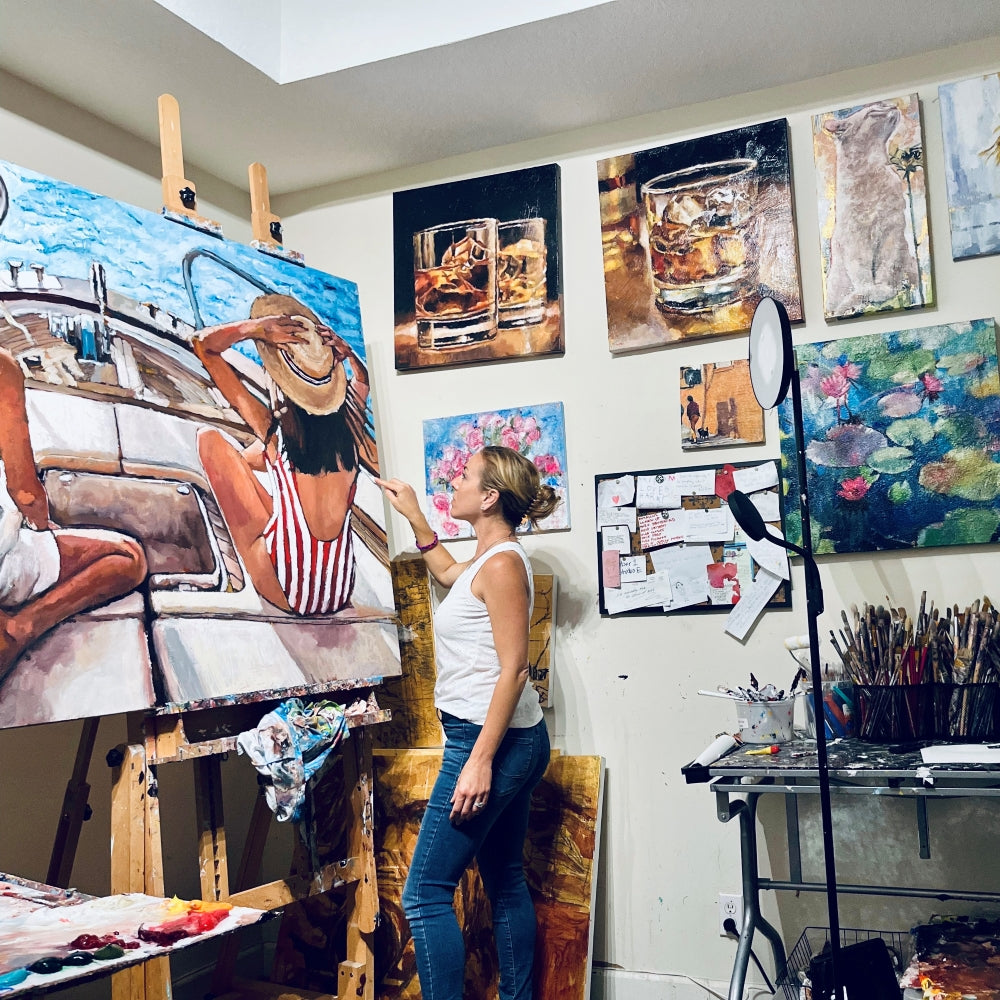A Creative Interview With Artist Nava Lundy



"A collector once told me my paintings felt like 'a memory you didn’t know you had.'”
Artist Nava Lundy creates impressionist paintings that radiate delicate feminine charm. Her creative journey took a transformative turn at 16. She met a teacher at a summer program who recognized her potential and encouraged her to find her voice as an artist. The teacher gave her a queen-sized bedsheet to paint on and let her work in the studio overnight. Nava created a piece that honors her grandmother who survived the Holocaust. The exercise changed her artistic direction. Years later, Nava paints in her cluttered home studio, accompanied by her dogs and occasionally music. When not making art, Nava spends quality time with her family or enjoys her alone time with a strong cup of coffee.
In this interview, Nava shares her love for her family, her creative process, and the influences that shape her art.
What’s your home life like?
I live in South Florida with my husband, our three kids—twin daughters and a son—and our sweet dog, Shmuley. Our home life is lively and full of connection. We spend a lot of time on the field and court—our daughters play lacrosse and soccer, and our son plays soccer and basketball. The girls also compete in duo interpretation debate, which adds another layer of creativity to our home. One of the things I’m most proud of is that, through it all, our kids are kind, thoughtful, and grounded. We also love art, travel, theater, and spending quality time together.
What are you most proud of—whether in art or another part of your life?
I’m proud of building a life where I can create meaningful work while staying deeply connected to my family. Raising kind, curious children and continuing to grow as an artist has been my greatest accomplishment. Artistically, being featured in the Kips Bay Palm Beach Showhouse this year was a very meaningful milestone.
Do you have any studio rituals that help you get into a creative flow?
Music always starts my process. I create playlists that match the emotional tone I’m working with. I’ll light a candle, clear some space, and begin with sketches or loose brushwork to let intuition lead the way. That early movement helps settle me into the work.
How do you structure your day?
Mornings are centered around family—getting the kids off to school. Then, I head to the studio and aim for uninterrupted stretches of painting. Afternoons usually involve a mix of creative and practical tasks. Evenings are for family. Sometimes, if inspiration strikes, I’ll return to the studio late at night.

Where do you find inspiration for your art?
I’m inspired by the quiet poetry of everyday life—small gestures, subtle emotions, fleeting light. I’m always drawn to moments that feel personal yet universal. Much of my work reflects themes of connection, memory, and the beauty of ordinary intimacy.
Tell us about the evolution of your style.
I began with detailed portraiture, focused on technique and realism, but my style has grown more expressive over the years. Now I’m more interested in capturing feeling than exact form. Whether it’s a child looking at a painting or siblings on a boat, I aim to evoke something emotional and timeless.
How do you decide when an artwork is finished?
It’s usually when the painting feels quiet—when it stops asking questions and feels like it’s speaking clearly. I like to let it sit for a few days and revisit it with fresh eyes before making a final call. I always aim to leave space for the viewer to bring their own interpretation.
What is the most interesting observation someone has made about your work?
A collector once told me my paintings felt like “a memory you didn’t know you had.” That stayed with me—because that’s what I hope to do: create work that touches something emotional and familiar in the viewer without needing explanation.
Is there an artwork from another artist that has had a significant impact on you?
Alice Neel has been a big influence. Her work is honest and emotionally raw. I admire how she captured the soul of her subjects with such power and vulnerability—something I always strive to do in my own way.
What’s your favorite museum?
The Philadelphia Museum of Art is my favorite. I studied in Philadelphia and spent countless hours there. It was formative for me as a young artist and holds a lot of inspiration and nostalgia.

Is there anything else you’d like to share to help viewers better understand your work?
Every painting is an invitation to pause and feel. I try to capture the in-between moments—where something real and meaningful lingers beneath the surface. My work is about emotion, memory, and the quiet power of human connection.
Discover more artist features on UGallery
If you enjoyed this article about Nava Lundy's life and artwork, we recommend reading about Karen Barton's impressionist animal paintings and Mark Cudd's modern portraits.







